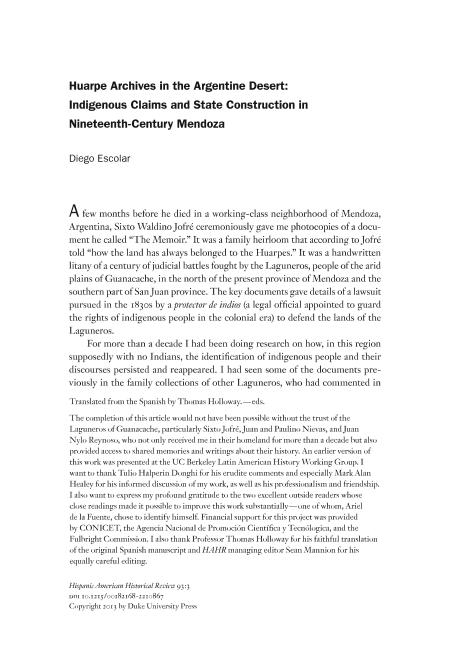Mostrar el registro sencillo del ítem
dc.contributor.author
Escolar, Diego

dc.date.available
2015-12-17T17:59:16Z
dc.date.issued
2013-08
dc.identifier.citation
Escolar, Diego; Huarpes archives in the Argentine Desert: Indigenous claims and state construction in nineteenth-century Mendoza; Duke University Press; Hispanic American Historical Review; 93; 3; 8-2013; 451-486
dc.identifier.issn
0018-2168
dc.identifier.uri
http://hdl.handle.net/11336/3008
dc.description.abstract
The narrative of indigenous extinction and the construction of a "white" Argentina entailed an ethnogeographic imaginary by which the territories of the former Spanish colonies were inhabited since the nineteenth century by gauchos or eventually peasants. The population classified as indigenous, in this view, was projected outside the central areas controlled by the nation-state,beyond the frontiers of the Pampas, Patagonia, and the Chaco. Historical writing accepted and contributed to the formation of this image by characterizing the political mobilization of gauchos or peasants (especially in their bellicosity as montoneras - irregular militia units) as a natural reflection of the projects of elites, factions, patrons, or parties. That historiography dismissed as irrelevant any demands stemming from the gauchos and peasantry themselves, such as those based on the long historical experience of indigenous peoples. Based on documents preserved by inhabitants of the travesía, or the desert,of Guanacache, in the central Cuyo region, the descendants of the Huarpes Indians who were considered extinct in the seventeenth century, this analysis stresses the continuity of indigenous claims and the political strategies of the communities of the countryside during the nineteenth century. While recognizing that other factors were involved in political mobilization, this analysis shows the primary importance of indigenous claims in an area of traditional montonera rebellion and civil conflict, and the active participation of the region in the construction of the state beginning in the 1820s. Indigenous leaders who also served as government officials pressed for institutionalized recognition of indigenous rights. That pressure eventually led to the acceptance of their claims and the maintenance of relative political autonomy until the 1870s.
dc.format
application/pdf
dc.language.iso
eng
dc.publisher
Duke University Press

dc.rights
info:eu-repo/semantics/openAccess
dc.rights.uri
https://creativecommons.org/licenses/by-nc-sa/2.5/ar/
dc.subject
Huarpes
dc.subject
Demandas de Tierras
dc.subject
Protectores de Indios
dc.subject
Siglo Xix
dc.subject.classification
Arqueología

dc.subject.classification
Historia y Arqueología

dc.subject.classification
HUMANIDADES

dc.title
Huarpes archives in the Argentine Desert: Indigenous claims and state construction in nineteenth-century Mendoza
dc.type
info:eu-repo/semantics/article
dc.type
info:ar-repo/semantics/artículo
dc.type
info:eu-repo/semantics/publishedVersion
dc.date.updated
2016-03-30 10:35:44.97925-03
dc.journal.volume
93
dc.journal.number
3
dc.journal.pagination
451-486
dc.journal.pais
Estados Unidos

dc.journal.ciudad
Durham
dc.description.fil
Fil: Escolar, Diego. Consejo Nacional de Investigaciones Científicas y Técnicas. Científico Tecnológico Mendoza. Instituto Argentino de Nivología, Glaciología y Ciencias Ambientales; Argentina
dc.journal.title
Hispanic American Historical Review

dc.relation.alternativeid
info:eu-repo/semantics/altIdentifier/url/http://hahr.dukejournals.org/content/93/3/451.abstract
dc.relation.alternativeid
info:eu-repo/semantics/altIdentifier/doi/http://dx.doi.org/10.1215/00182168-2210867
Archivos asociados
